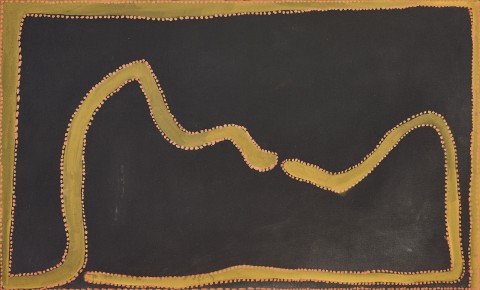STATION HILL, TEXAS DOWNS, 1991
ROVER THOMAS (JOOLAMA)
natural earth pigments on canvas
59.5 x 100.0 cm
Mary Macha, Perth
Private collection, Melbourne
To paraphrase the early twentieth century avant-garde artist Paul Klee, Rover Thomas was adept at taking a line for a walk. In Station Hill, Texas Downs, 1991 the central linear arch emanating from the painted frame of the composition – a metaphorical frame of reference – divides the top of Station Hill from the bottom according to the artist’s description of his image. The tension within the composition is achieved through the yellow ochre line angling and curving back on itself in the lower right register of the painting, approaching but not touching either the frame or the arching form at the focal point of the work. (According to Thomas, this is a ‘gap’ through which kangaroos are corralled.) Two lines in opposition, forming a space within a space. The artist’s assured, rhythmical lightness of touch creates an image of stark dynamism.
Thomas’ genius lay in his ability to achieve such complex visions through the most minimal of means. Station Hill, Texas Downs is comparable in this respect to paintings such as Frog Hollow country, 1987, in the collection of the National Gallery of Australia, where the meandering lines represent roads to towns and settlements, and tracks to an ancestral site.1 A similar rendition of mapping roads for cars appears in Yunurr (Spring Creek), 1991, in the collection of the National Gallery of Victoria.2 And in Gurirr Gurirr Serpent Wungkurr of 1994, in the collection of the Fondation Opale, the wandering line becomes the Rainbow Serpent of Thomas’ revelatory Gurirr Gurirr ceremony about the destruction of Darwin by the snake in the guise of Cyclone Tracy in 1974.3
As in many of Thomas’ paintings of country, the perspective can be ambiguous; one is either looking down on the landscape in plan view, in profile, as if one were standing in the landscape; or, as in Station Hill, Texas Downs, both perspectives operate simultaneously.
1. Thomas, R. with Akerman, K., Macha, M., Christensen, W., and Caruana, W., Roads Cross: The paintings of Rover Thomas, National Gallery of Australia, Canberra, 1994, pp. 13 and 58 (illus.)
2. Planella, G. (ed.), Porta Oberta al Dreamtime: Art Aborigen Contemporani d'Austràlia, 1971-2003, Fundació Caixa de Girona, Girona, Spain, 2004, pp. 40-1 (illus.); and illustrated on the National Gallery of Victoria’s website at https://www.ngv.vic.gov.au/essay/rover-thomas-yunurr-spring-creek/
3. Petitjean, G. and Primat, B., (eds.), Before Time Began, Fondation Opale, Lens, Switzerland, and 5 Continents Editions, Milan, 2019, cat. 61, p. 124 (illus.)
WALLY CARUANA
